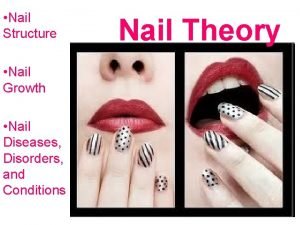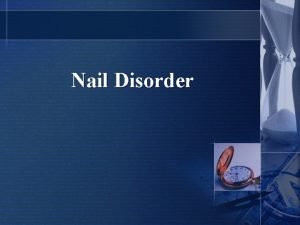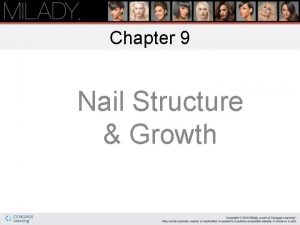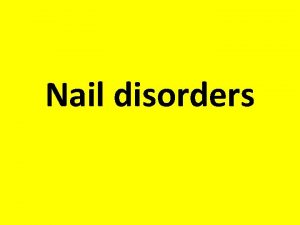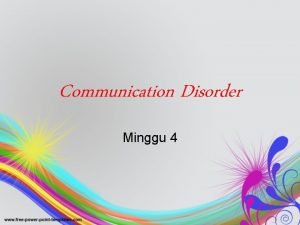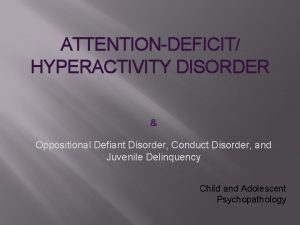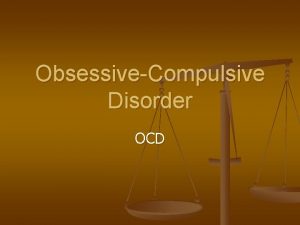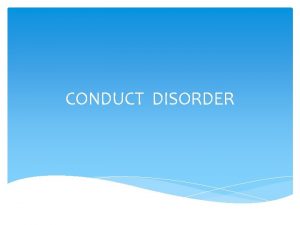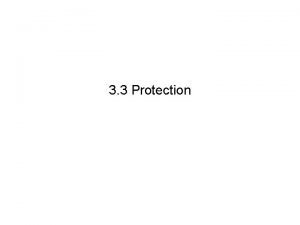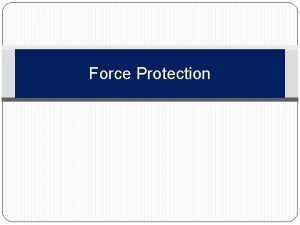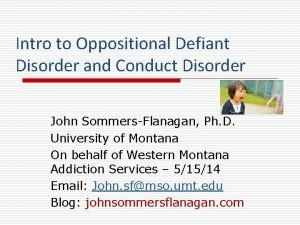Nail Disorder Functions of the nail unit Protection






















- Slides: 22

Nail Disorder

Functions of the nail unit Protection of the phalanges and fingertips. Enhancement of fine touch and fine digital movements. Scratching and grooming. Aesthetic and cosmetic organ.

Components of the nail unit Generating portion: nail martrix. Product portion: nail plate. Ensheathing portion: cuticular system. Supporting portion: nail bed mesenchyme (dermis) and phalangeal bone. Anchoring portion: ligaments. Framing portion: nail folds.

Modes of keratinization of the epithelial components of the nail Onychokeratinization: occurs in the matrix epithelium, the product is the hard keratin of the nail plate.

Modes of keratinization of the epithelial components of the nail Onycholemmal keratinization: semihard keratin 8 Ventral portion of the proximal nail fold---true cuticle. 8 Bed epithelium---bed horny layer. 8 Distal bed epithelium---thicker solehorn.

Modes of keratinization of the epithelial components of the nail Epidermoid keratinization: soft keratin. 8 Epithelium of the dorsal portion of the proximal nail fold---eponychium. 8 Epithelium of the lateral nail fold and paronychial skin. 8 Epithelium of hyponychium---hyponychial horn and volar skin.

Lunula is the visible portion of the nail matrix. Nail matrix consists of a thick epithelium with no granular layer and a thick keratogenous zone.

Nail bed Pink color. Some brown pigment may be seen as a diffuse or streaked pattern. Splinter hemorrhage: RBC in the horny layer of the bed epithelium.

Nail plate growth Average growth rate of the fingernail: 0. 1 mm/day--3 mm/month--- A normal fingernail grows out completely in about 6 months. Toenails grow at half to one third the rate of the fingernails.

Nail plate growth Faster: 8 8 8 8 8 Proportional to the length of the fingers. Dominant hands. Males. Worm climate. Day. Pregnancy. Local trauma: Nail bitter, typing, piano playing. Hyperpitutalism, hyperthyroidism. Peak between 10 to 14 y/o.

Nail plate growth Slower: 8 Paralyzed limbs. 8 Decreased circulation. 8 Malnutrition. 8 Yellow nail syndrome. 8 Acute infection. 8 During therapy with antimitotic drugs.

Nail plate thickness The length of the matrix determine thickness of the nail plate. Thinner proximally. 0. 5 mm thick in women and 0. 6 mm thick in men. Thumb > index > middle > ring > little finger. Progressive increase thickness with age.

Nail changes in older individuals Color: 8 Lanula is often decreased or absent. 8 Nail plate: yellow to gray discoloration. Contour: 8 Transverse convexity increased, longitudinal convexity decreased. Linear growth rate: decreased.

Nail changes in older individuals Surface: 8 Friability, splitting, fissuring, and onychorrhexis. 8 Onychorrhexis: superficial longitudinal striation, not limited to the elderly, also described in gout, hypothyroidism, lichen planus, psoriasis, Reiter’s disease, scleroderma.

Nail changes in older individuals Thickness: variable--fingernails often become soft and fragile, whereas the toenails are usually thicker and harder. Pachyonychia: thickening of the entire nail plate. Onychauxis: localized nail plate hypertrophy.

Nail changes in older individuals Thickness: variable--fingernails often become soft and fragile, whereas the toenails are usually thicker and harder. Pachyonychia: thickening of the entire nail plate. Onychauxis: localized nail plate hypertrophy.

Nail changes in older individuals Brittle nails: 8 Distal nail plate: excessive longitudinal ridging, horizontal layering (lamellar separation). 8 Distal edge: irregularity. 8 Nail plate surface: roughness (Trachyonychia)

Nail changes in older individuals Brittle nail: 8 The normal water content of the nail plate is about 18%. 8 Brittle nails appear in dry environments, when the water content decreases below 16%. 8 Many elderly individuals acquire the nails secondary to repetitive hydration and dehydration cycles or from excessive use of dehydrating agents.

Nail changes in older individuals Faulty biomechanics and trauma---- chronic trauma to the nail unit can result from faulty biomechanics---- onychodystrophy. 8 Onychauxis 8 Onychoclavus (subungual corn). 8 Onychocryptosis. (Ingrown toenails) 8 Onychogryphosis. 8 Subungual exostosis. 8 Subungual hematoma. 8 Subungual hyperkeratosis.

Nail changes in older individuals Onychomycosis: 8 Distal and lateral subungual OM. 8 Proximal subungual OM. 8 Superficial white OM. 8 Total dystrophic OM. 8 Candidal OM.

Types of abnormality resemble Onychomycosis Longitudinal ridging. Transverse layering and splitting. Thickening. Separation of the nail plate. Discoloration. Inflammatory nail disorders. Pitting.

Types of abnormality resemble Onychomycosis Longitudinal ridging: 8 Shallow furrows: age, twenty nail dystrophy, rheumatoid arthritis, lichen planus, peripheral circulation disorder. 8 Deeper furrows: lichen planus, alopecia areata, Darier’s disease, trauma. 8 Deep wide: tumors. Mucous cyst, warts. 8 Single usually in the thumb nail: Median nail dystrophy.
 Factitious disorder
Factitious disorder Milady chapter 10 review questions
Milady chapter 10 review questions Overgrown eponychium
Overgrown eponychium Inverse pterygium nail
Inverse pterygium nail Lanula nail
Lanula nail Eat disorder york
Eat disorder york Chapter 9 nail structure and growth
Chapter 9 nail structure and growth Unit 10, unit 10 review tests, unit 10 general test
Unit 10, unit 10 review tests, unit 10 general test High pressure protection error
High pressure protection error Hát kết hợp bộ gõ cơ thể
Hát kết hợp bộ gõ cơ thể Frameset trong html5
Frameset trong html5 Bổ thể
Bổ thể Tỉ lệ cơ thể trẻ em
Tỉ lệ cơ thể trẻ em Chó sói
Chó sói Thang điểm glasgow
Thang điểm glasgow Chúa sống lại
Chúa sống lại Môn thể thao bắt đầu bằng từ chạy
Môn thể thao bắt đầu bằng từ chạy Thế nào là hệ số cao nhất
Thế nào là hệ số cao nhất Các châu lục và đại dương trên thế giới
Các châu lục và đại dương trên thế giới Công của trọng lực
Công của trọng lực Trời xanh đây là của chúng ta thể thơ
Trời xanh đây là của chúng ta thể thơ Mật thư anh em như thể tay chân
Mật thư anh em như thể tay chân Làm thế nào để 102-1=99
Làm thế nào để 102-1=99


